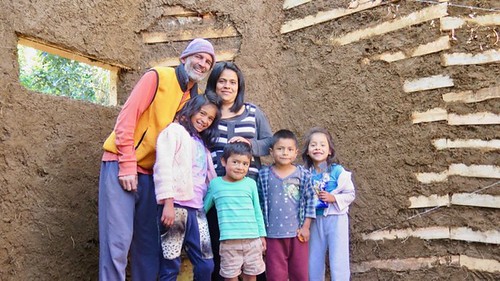Editor’s note: This photo story is part of a series about “bio-reconstruction” or natural building initiatives that are springing up in the wake of the earthquakes in Mexico. To follow some of these developments see the Facebook page for BioReconstruye México, a network of natural builders around the country who are sharing techniques and coordinating efforts to respond to the need for housing in ways that care for the environment.
By Tracy L. Barnett
Mari Neri Aguilar will never forget the terrible feeling of the ground heaving beneath her feet and the sounds of her home and those of the neighbors cracking and falling to the ground. She gives thanks that the quake happened in the daytime; otherwise, she says, “my children would no longer be with me, because their beds were filled with rubble.”
Mari and her four children lost their home in Tetela del Volcán, in the foothills of Volcano Popocatepetl in the Sept. 19 earthquake that hit Mexico City and the surrounding states.
Bioconstructor José Rosas of Valle del Bravo had done a project in the area and heard about Mari’s case. First he inquired through a friend whether she was up for it. When she agreed, he decided to organize a workshop to share some low-cost natural building techniques with the local residents – “to teach them to fish, instead of just giving them fish,” he explained.
In just six days and for under $1,000, he and his crew – together with Mari’s family and neighbors – built a starter home using wooden pallets, cob (mud mixed with straw or, in this case, pine needles), plastic bottles (for insulation), a few bags of cement (for the foundation), a few meters of barbed wire (for anti-seismic reinforcement), and a few timbers and sheets of galvanized steel for the roof.
Here’s how they did it.
At the time of our visit, Mari and her children were living in a shelter made of tarps and a bit of wood on the foundation of their former home.
When José first spoke to her of his idea to build her a home with pallets and plastic bottles and mud, she was dubious. “I wondered, am I going to end up with a pile of trash?” But as he explained his concept, she decided she had nothing to lose. And as the project began, she and the children and neighbors pitched in and lent a hand, learning about natural building techniques in the process.
On Day 6, she observed as her daughters happily patted handfuls of cob into place, her sons joyfully tossed gobs of the stuff into the air and members of the construction crew put the finishing touches on the north wall. “It’s going to be really beautiful,” she said. “Now I know there is a God.”
Hear José explain his technique in his own words:
